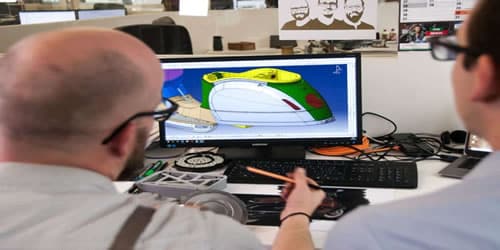A production management system is the core area, or main activity, of all types of businesses. Whether it is a manufacturing company or a service industry, all types of companies produce various goods and services for societal consumption, which is known as production management system. Today’s production management systems are highly digital, ensuring an agile supply chain. Production management software is changing the way many businesses track, manage and organize their production. While the digital world is changing the face of production management today, this article will enlighten you on the many ways in which production management can be carried out.
What Is a Production Management System?
A production management system, also known as operations management, ensures that the manufacturing and production of your goods or services run smoothly. Understanding the complexities of manufacturing and making adjustments to the way you run things is essential. You can also improve efficiency and productivity by assessing or evaluating your current workflow.
Similarly, enterprise resource planning (ERP) is the real-time management of your business processes, typically achieved through the use of a computer program. The software can help with production planning, allowing you to scale and grow your output to the next level. Using a powerful program that can keep up with demanding schedules and projects while also providing 3D visualization, collaboration, and analytics will set you apart from the competition.
What Are Main Objectives of Production Management?
The main objective of production management is to provide goods and services of the appropriate quality, quantity, time, and cost. It also attempts to enhance efficiency.
Why Use Production Management System?
If you’re still putting your manufacturing process in order and planning it by hand, it’s time to switch to something that’s made for manufacturing. You require something that will take you from design to fabrication, ultimately increasing output and efficiency.
A high-quality production management software program can provide the quality control you require to expand your business. From compliance initiatives to quality measurement and cost reduction, you also need a program that manages the entire product lifecycle. You can bridge the gap between planning and manufacturing by using cloud-based production management software.
Furthermore, if you are still relying on your office computer, you should consider cloud computing. The world is changing, and everyone now works from different locations. However, with cloud computing, your team can work from any location with an internet connection. Your team can use Onyx to upload their framed Revit project to a cloud server for easy sequencing, scheduling, editing, and CNC output from any web-enabled device without ever downloading the Revit file.
Who Needs Manufacturing Production Solutions?
Digital production management solutions like Onyx can help anyone who is planning or developing a production process. Don’t keep creating this roadmap using old techniques. But you can upgrade to a digital production management software program to stay competitive in your field. Onyx software, for example, enables you to optimize your manufacturing process while minimizing downtime. The onyx digital software also assists in increasing efficiency in production management, from scheduling to time tracking and staying within time constraints. Other digital production management software includes Oracle NetSuite ERP, Infor LN, CREST ERP, CONNETINBOT, and MobileERP.
What Are the Types of Production Management?
There are different types of production management software. A production manager must pick a suitable method for his unit. When choosing a method, you should think about the type of product and how much of it you want to make. Generally, in manufacturing, production management processes are typically broken down into three types: job production, batch production, and flow production.
#1. Job Production
Job production is the process of producing a product in response to specific customer orders. The manufactured goods are naturally not homogenous in any way. It generally refers to
- The provision of materials to a primary producer I
- The supply of a specific area of production to a large one; or
- Creation of specialized equipment or materials.
A single operation is considered to be the production of a single product. It is also the process of assembling and commissioning a single piece of equipment or product by bringing together materials, parts, and components. Job production includes a wide variety of industries and activities, such as shipbuilding, dam construction, bridge building, and book printing.
#2. Batch Production
Batch production is a type of repetitive production. It also refers to the production of goods whose quantity comes up upfront. The work is divided into operations in a batch system, and each operation is completed one at a time. When one operation is finished, it is passed on to the next, and so on until the product is finished. For example: If an Ai company wishes to produce 50 electric motors. The work will be broken down into operations. In the first batch, all the motors will undergo the first operation before moving on.
The second group of operators will finish the second operation before moving on to the third, and so on. Under job production, the same operators will produce the entire machine rather than just one operation. Batch production can reap the benefits of repetitive production to a large extent, provided the batch is large enough. Thus, batch production is the manufacture of a product in small or large batches or lots by a series of operations, with each operation performed on the entire batch before the next.
#3. Mass or Flow Production
Flow production, also known as online mass production and continuous production, refers to large-scale production on a continuous basis. Flow production is the process of producing a product through a series of operations, with each article moving on to the next operation as soon as possible. The manufacturing process has two distinct operations. When one step of production is complete, automatically it goes to the next. There is no time lag between the completion of one process and the beginning of the next. The production flow is continuous and progressive. These three types of production management mentioned above aid in the manufacturing process.
What Are the Five P’s of Production Management?
The five P’s are:
#1. The Product
The product is the link between manufacturing and marketing. It is not enough that a customer needs a product; the organization must also be capable of producing it. Different departments within the company reach an agreement on the following aspects of the product in accordance with the company’s product policy,
- Effectiveness
- Dependability and quality
- Design and ergonomics
- Amount and selling price
- Timetable for delivery
To arrive at the above, both external and internal factors affecting various aspects such as market needs, existing culture and legal constraints, and environmental demands must be taken into account. As a result, major policy decisions regarding product mix variety will have an impact on the manufacturing system.
#2. The Plant
The plant represents a significant investment (fixed assets). However, it should meet the needs of the product, the market, the worker, and the organization.
The plant takes care of;
- Building and office design and layout
- Reliability, perfection, and equipment maintenance.
- Operational security
- Financial limitations
Plant layout is concerned with the physical arrangement of plants and machinery within the chosen site. The layout should allow for the smooth movement of men and materials with minimal backtracking. The layout depends on the type of production, the volume of demand, and so on.
#3. The Procedure
There are always a variety of methods for creating a product. However, you can choose the best method for achieving the goals. It is necessary to consider the following factors when making a decision about the process:
- Capacity available
- Available manpower skills.
- Production method
- Plant layout
- Security
- Maintenance
- Manufacturing expenses
#4. The Programme
The term “program” refers to the production schedule. As a result, the program creates schedules for:
- Purchase
- transformation
- Care and upkeep
- Cash
- Storage and transportation
#5. The People
People are responsible for production. People differ in their attitudes, skills, and work expectations. Thus, in order to make the best use of available human resources, a good match between people and jobs is important, which may lead to job satisfaction. The production manager should be involved in decisions such as:
- Payroll and salary administration
- Working conditions and safety
- Inspiration
- Employee education
What Are the Characteristics of Production Management?
#1. Everyone’s Efforts Are Focused on Core Operational Competencies That Help the Business Strategy
All employees have a firm grasp of the significance of the organization’s prioritized operational competencies and are also actively working to put them into practice for the benefit of the business.
As a result of having a clearly defined and documented set of practices and business processes to manage, monitor, and enhance the operation across the board, the organization is process dependent rather than person dependent.
#3. Everyone Has the Ability to Contribute to the Success of the Operation.
Empowerment occurs when capability and accountability intersect. Some organizations make the mistake of focusing solely on increasing employee accountability without adequately investing in their capabilities. Employee performance won’t improve just because they’re held accountable, any more than a child can dunk a basketball or play a Mozart piano concerto because his parents tell him to.
#4. Well-Defined Process for Identifying “Best Practices,” Developing Capability, and Appropriately Replicating Them.
A major benefit of a systemic approach is that it fosters natural opportunities for collaboration and knowledge sharing, which significantly accelerates the rate of improvement. However, the enterprise-wide collaboration will not occur naturally unless the organization promotes it and removes the barriers that impede it (e.g., geographic, language, lack of relationships, lack of transparency, etc.)
What Are Principles of Production?
7 Primary Principles of Production Management
#1. Shorter Set-Up Times.
Setup processes waste labor and equipment by their very nature. For example, Toyota was able to reduce set-up times by training employees, improving efficiency, and holding them accountable for their own setups.
#2. Small-Scale Manufacturing.
Cutting set-up costs and time allows a company to produce goods in smaller batches and on demand. As a result, set-up, capital, and energy costs are reduced.
#3. Employee Empowerment
Splitting a large group of people into smaller teams and giving them responsibility for tasks like housekeeping and maintenance also increases productivity. Teams are given leaders, and the people on those teams are trained in maintenance issues so that they can deal with production delays right away.
#4. Upkeep of Equipment.
Workers on the front lines are best equipped to handle mechanical breakdowns and subsequent repairs. They can also respond to issues quickly and frequently without supervision, allowing the production process to resume much more quickly after a shutdown.
#5. Pull Production.
This principle, also known as “Just in Time” (JIT), aims at producing goods solely based on demand at any given time, thereby eliminating unnecessary costs. For example, Toyota pioneered a system in which the number of materials, labor, and energy used at each stage of production was solely based on demand from the next stage.
#6. Supplier Participation.
Toyota showed that there were many advantages to viewing suppliers of both components and raw materials as an integral part of the manufacturing process itself. In order to better serve Toyota, suppliers were educated on the company’s methods, tools, and inventory management and assembly processes. As a result, when problems arose, their suppliers were able to respond positively and quickly.
Conclusion
A production management system, also known as operations management, ensures that the manufacturing and production of your goods or services run smoothly. Well, I hope this post helped you appreciate the production management system
Production Management System FAQs
What is production management, with examples?
Production management is the planning, organizing, directing, and controlling of all production activities. It also combines the six main elements of money, men, materials, machines, markets, and methods to meet the various needs of people.
What are the roles of production management?
What does a production manager do?
- Production schedule planning and organization
- Determining project and resource needs
- Budgeting, scheduling, and negotiation with clients and supervisors.
- Ensuring compliance with health and safety regulations
- Establishing quality control guidelines.
Which software is best for manufacturing?
Oracle NetSuite ERP, Infor LN, CREST ERP, CONNETINBOT, and MobileERP are the best Manufacturing Software for your company. Manufacturing software is a module of manufacturing ERP software that simplifies factory operations.
Related Articles
- Transaction Processing System: How it Works With Examples (Detailed Guide)
- Capital Resources Definition: Why It Is Key For All Businesses
- Canadian Whiskey Bands: Best Top 25+ Canadian Whiskey Brands.
- OPERATIONS MANAGEMENT SYSTEMS: Types, Features, and Process
- MATERIAL MANAGEMENT SYSTEM: Guide To The Material Management Process




![Daily Planner: Best Free Apps to Install in 2023[IPHONE & Android]](https://businessyield.com/wp-content/uploads/2023/04/plann-380x220.png)


1 comment
Vielen Dank für Erklärungen rund um das Thema Produktionsmanagementsysteme. Gut zu wissen, dass bei der Lohnfertigung die gleichen Bediener die gesamte Maschine und nicht nur einen Arbeitsgang produzieren. Gilt das genau so für die CNC Lohnfertigung?